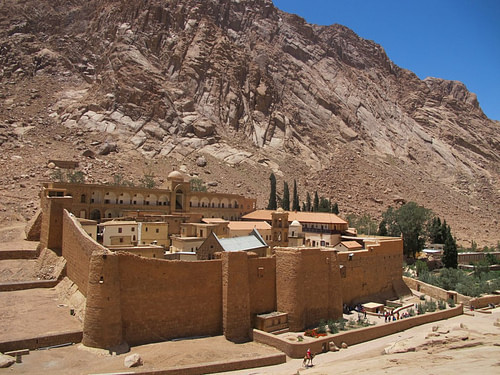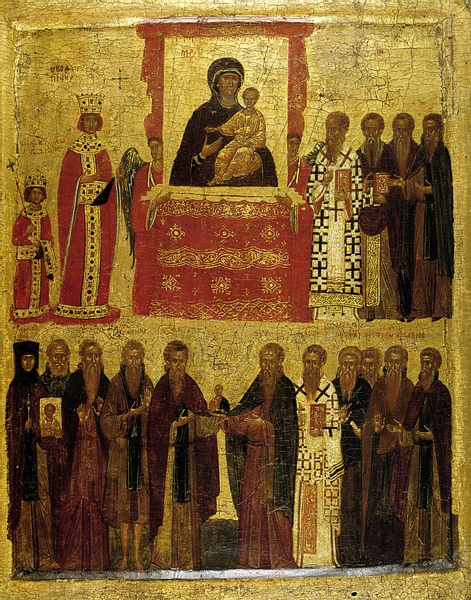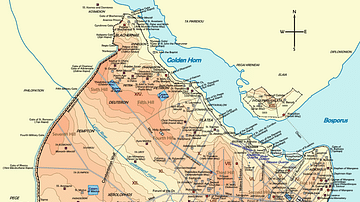Monasticism, that is individuals devoting themselves to an ascetic life in a monastery for devotional purposes, was an ever-present feature of the Byzantine empire. Monasteries became powerful landowners and a voice to be listened to in imperial politics. From fanatical ascetics to much-appreciated wine-producers, men and women who devoted their lives to a monastic life were an important part of the community with monasteries offering all manner of services to the poor and needy, out-of-favour nobles, weary travellers, and avid bookworms. Many Byzantine monasteries are still in use, and their impressive architecture enhances views today from Athens to Sinai.

Origins & Development
Leading a life of asceticism, when one denied oneself of basic comforts, was a concept seen in the Jewish faith and, of course, by Jesus himself when he had spent time in solitude in the wilderness, and in the lives of his followers such as John the Baptist. The idea was that shorn of all distractions an individual could be closer to God. In the 3rd century CE, the deserts of Egypt were a particular hotspot for wandering ascetics (aka anchorites or eremites) who lived hermit lives of self-denial, the most famous being Saint Anthony (c. 251-356 CE). Most ascetic hermits were men, but there were some women, notably the reformed prostitute Saint Mary of Egypt (c. 344 - c. 421 CE) who spent 17 years in the desert.
Monasticism developed in the 4th century CE and became more widespread from the 5th century CE when monks began to move from their lonely desert retreats and live together in monasteries closer to or actually in towns and cities. One of the earliest ascetics to begin organising monasteries for his followers was Pachomios (c. 290-346 CE), an Egyptian and former soldier who, perhaps inspired by the efficiency of Roman army camps, founded nine monasteries for men and two for women at Tabennisi in Egypt. These first communal (cenobitic) monasteries were administered following a list of rules compiled by Pachomios, and this style of communal living (koinobion), where monks lived, worked, and worshipped together in a daily routine, with all property held in common, and an abbot (hegoumenos) administering them, became the common model in the Byzantine period.
A variant on, and indeed precursor of, the communal monastery was the lavra which permitted individual monks to pursue their own independent asceticism. As opposed to the communal monasteries, in the lavra the monks lived, worked, and worshipped in their own private cells. The monks were not fully independent as they remained answerable to an archimandrite or administrator and they did join their fellow monks in occasional services in a common church. In later times the term lavra was also applied to some ordinary communal monasteries, most famously the Great Lavra on Mount Athos (see below), founded c. 962 CE.
The most prominent early supporter of Byzantine monasteries during the 4th century CE was Basil of Caesarea (aka Saint Basil or Basil the Great) who had seen for himself the monasteries in Egypt in Syria. Basil believed that monks should not only work together for common goals but also contribute to the wider community, and he set up monasteries to that effect in Asia Minor. The monks were often supported by devout aristocrats who provided them with vacant villas so that their accommodation was not always as austere as one might imagine. There were, though, urban monasteries which did follow the principles of asceticism to the letter, following the example of the classic monasteries in remote geographical locations.
The first monastery in Constantinople was the Dalmatos, founded in the late 4th century CE, and by the mid-6th century CE, the capital had nearly 30 monasteries. In the Byzantine Empire, monasteries were largely independent affairs, and there were no specific and mutually administered orders as in the Western Church. A typical Byzantine monastery could have many facilities within its walls: a church, chapel, baths, cemetery, refectory, kitchens, accommodation, storerooms, stables, and an inn for visitors.
Mountains seemed to attract monks more than any other location, and in turn, pilgrims visited their monasteries to feel closer to their God and, in many cases, to seek miraculous interventions. Mount Sinai, Mount Auxentios, Meteora, and Mount Olympos in Bithynia with its 50 monasteries were the most celebrated monastic sites. Most monasteries were independent of each other even when in the same location, but there were sometimes monasteries which were tied together by one abbot or first monk (protos) overseeing a confederation. Perhaps the most famous of all monastic sites was on Mount Athos, east of Thessaloniki, which was probably founded in the 9th century CE, if not earlier, and which includes monasteries founded by foreign monks from Bulgaria, Armenia, Serbia, and Russia, to name a few. Mount Athos remains an important site of monasticism today and, thanks to its avoidance of destructive invasions over the centuries, is a well-preserved example of Byzantine monastic life.
Always self-sufficient by working their own land, from the 10th century CE Byzantine monasteries became even larger and wealthier, their income derived from the often vast landholdings given to them by emperors and private individuals over time, and from their preferential tax treatment by the state. Quite often a monastery's lands had no geographical connection to the monastery itself, and revenue was gained from the rent of plots or sale of smallholdings. Monasteries produced such staples as wheat, barley, pulses, wine, and oil, but they could also own potteries and mills. Profits from surpluses were ploughed back into the monastery or distributed to the poor.
The Stylites
Another form of monastic existence, and certainly the most bizarre, was the stylite movement. The ascetic lifestyle to beat all others, it involved a single devoted monk climbing to the top of a column (stylos) and staying there, preferably standing, for months or even years exposed to all weather and, one imagines, an equal dose of awe and ridicule from passerby. Ordinary folk were well-used to monks and nuns abstaining from life's comforts and pleasures, and they had even seen them wearing chains or heard of ascetics locking themselves in cages, but the column stance was guaranteed to get one noticed.
The first proponent of this extreme devotion to God was said to have been Symeon the Stylite the Elder (c. 389-459 CE). The former shepherd had already been expelled from a monastery for his extreme asceticism, and he practised for his column routine by living for a while in a disused cistern with one leg chained to a heavy stone. Symeon selected a three-metre-high column in the Syrian desert near Antioch, and there he stood day in, day out, eventually attracting such a crowd that the noise caused him to build his column higher, bringing him closer to God and 16 metres off the ground. Symeon managed to live like this for 30 years, and many other monks began to follow his example so that a whole stylite movement developed which was still going strong in the 11th century CE. When Symeon died, the site of Qal'at Sem'an became one of pilgrimage, with an octagonal church, monastery, and four basilicas built around the original column.
One the most famous Symeon imitators was Daniel the Stylite (d. 493 CE). Daniel set himself up near Constantinople but did not let his precarious position stop him contributing to ecclesiastical debates, and he even advised bishops and emperor Leo I (r. 457-474 CE). A branch of the stylite movement (literally) was the dendrites who were monks who decided to live in a tree instead of on a column. These movements were part of the trend of apophatic theology which proposed that one could come to know and understand God through personal experience provided all worldly distractions were removed.
Monasteries & the State
The monasteries, and the monks who worked and worshipped in them, eventually became a useful means for bishops to exert pressure on their ecclesiastical rivals. Fanatically loyal monks were organised into groups to intimidate anyone who did not adhere to a bishop's favoured dogma. Mob violence over political and religious issues was often fuelled by monks. The bishops of Alexandria were particularly noted for using monks and other such devotees as the parabalani, semi-clerical workers often misleadingly referred to as “bath attendants,” to add muscle on the streets to their sermons from the pulpit.
Byzantine emperors could be both friend and foe to monasteries. Many emperors gave land grants and tax privileges, but others also persecuted them, especially the iconoclast emperors. These latter were responsible for the iconoclasm movement of the 8th and 9th century CE which sought to end the veneration of icons and relics and destroy them. The monasteries, being the main producers and sponsors of such items, were targeted too. In 755 CE, for example, the Pelekete monastery on Mt. Olympus was burnt down. Many others suffered a similar fate or had land and property confiscated while monks were persecuted and paraded in ceremonies of public ridicule. The 14th century CE saw another wave of persecution, this time over the issue of Hesychasm, that is the practice of monks repeating a prayer to achieve mystical communion with God.
Although religiously independent, there is evidence that Byzantine monasteries and their residents were subject to civil law like everyone else. Local judges conducted legal investigations, and monks could even be called before the courts in Constantinople.
Emperors were well aware of the influence monasteries had on local populations. For example, rulers selected the abbots of such important monasteries as those on Mount Athos, a duty taken on by the bishop of Constantinople from the 14th century CE. Another problem was that as the number of monasteries increased so the tax revenue of the state decreased. The situation moved emperor Romanos I Lekapenos (r. 920-944 CE) to forbid the founding of new monasteries to protect the land of ordinary villagers, but it proved only a temporary stop to the seemingly inevitable spread of monasteries, such was their success and use to society as a whole.
Cultural Contributions
Although it was not their primary purpose of existence, monks and monasteries did give back to the community in which they lived by helping the poor and providing hospitals, orphanages, public baths, and homes for the aged. Even retired aristocrats and out of favour politicians and imperial relations were welcomed. Travellers were another group who could find a room when needed. In education, too, monasteries played a prominent role, notably building up large libraries and spreading Byzantine culture when monks travelled across and outside the empire. Some (but not many) also provided schools. Monasteries looked after pilgrim sites and were great patrons of the arts, not only producing their own icons and illuminated manuscripts but also sponsoring artists and architects to embellish their buildings and those of the community with images and texts to spread the Christian message. Finally, many monks were important contributors to the study of history, especially with their collections of letters and biographies (vitae) of saints, famous people, and emperors.












